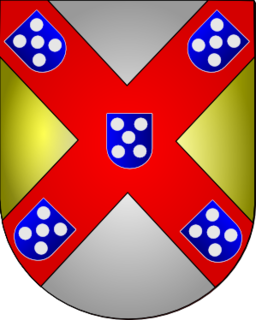
Afonso III, or Affonso, Alfonso or Alphonso (Portuguese-Galician) or Alphonsus (Latin), the Boulonnais, King of Portugal was the first to use the title King of Portugal and the Algarve, from 1249. He was the second son of King Afonso II of Portugal and his wife, Urraca of Castile; he succeeded his brother, King Sancho II of Portugal, who died on 4 January 1248.

Sancho I, nicknamed "the Populator", King of Portugal was the second but only surviving legitimate son and fifth child of Afonso I of Portugal by his wife, Maud of Savoy. Sancho succeeded his father and was crowned in Coimbra when he was 31 years old on 9 December 1185. He used the title King of Silves from 1189 until he lost the territory to Almohad control in 1191.

The Most Serene House of Braganza, also known as the Brigantine Dynasty, is a dynasty of emperors, kings, princes, and dukes of Portuguese origin which reigned in Europe and the Americas.

Dom Afonso I of Braganza was the first duke of Braganza and the eighth count of Barcelos. He founded the House of Braganza, the most powerful and wealthy dynasty in Portugal. His descendants became high-ranking nobles, imperial officials, and finally kings of Portugal and emperors of Brazil.
The highest hereditary title in the Portuguese monarchy. By tradition, there are a total of five royal and seven non-royal dukes in Portugal, out of 28 dukedoms that have ever been created. In the majority of cases, the title of duke was attributed to members of the high nobility, usually relatives of the Portuguese Royal Family, such as the second son of a monarch.
Constable of Portugal was an office created by King Ferdinand I of Portugal in 1382, to substitute the High Standard-bearer (Alferes-Mor) as the head of the Portuguese Military. It was also referred as the Constable of the Kingdom.

Count of Cantanhede was a Portuguese title of nobility created by a royal decree, dated from 6 August 1479, by King Afonso V of Portugal, and granted to D. Pedro de Menezes, 5th Lord of Cantanhede.

The title duke of Terceira, de juro e herdade was created by decree of King Pedro IV of Portugal, on 8 November 1832. António José de Souza Manoel de Menezes Severim de Noronha, 7th Count of Vila Flor, de juro e herdade, and 1st Marquis of Vila Flor, was the first holder of the title.
Diogo Gil Moniz was a Portuguese nobleman.

The Dukes of Cadaval have their origins in Dom Álvaro of Braganza, Lord of Tentúgal, Póvoa, Buarcos and Cadaval, 4th male son of Dom Ferdinand I, 2nd Duke of Braganza. Dom Álvaro married Dona Filipa de Melo, the rich daughter and heir of Rodrigo Afonso de Melo, 1st. Count of Olivença.

Álvaro of Lencastre (1540–1626) was the son of Afonso of Lencastre, second son of infante George of Lencastre, 2nd Duke of Coimbra.
Álvaro of Braganza was the 4th son of Ferdinand I, 2nd Duke of Braganza and his wife, Dona Joana de Castro.

Count of Valença was a Portuguese title of nobility, created by a royal decree, dated from July 20, 1464, by King Afonso V of Portugal, and granted to Dom Henrique de Menezes, who was already 3rd Count of Viana and 4th Count of Viana.

Count of Tentúgal was a Portuguese title of nobility created by a royal decree, dated from 1 January 1504, by King Manuel I of Portugal, and granted to DomRodrigo de Melo, son of Álvaro of Braganza and Philippa of Melo.

Isabella of Portugal (1364–1395) was the natural daughter of King Ferdinand I of Portugal, from an unknown mother.
Manuel of Menezes was the second son of Pedro de Menezes 5th Marquis of Vila Real and of his wife, Beatrice of Lara.

Count of Faro was a Portuguese title of nobility granted by royal decree issued on 22 May 1469, by King Afonso V of Portugal, to D. Afonso of Braganza, the third son of Fernando I, Duke of Braganza.
RodrigoAfonso de Melo, 1st Count of Olivença was a Portuguese nobleman, son of Martim Afonso de Melo, Lord of Ferreira de Aves e Chief-Guard of king Edward of Portugal.
Juan de la Cerda y Silva, 4th Duke of Medinaceli, Grandee of Spain, was a Spanish nobleman.
Fadrique de Portugal was a Portuguese politician and cleric.












